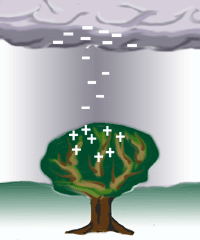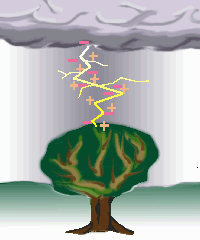
Lightning is the most spectacular element of a thunderstorm. In fact it is how thunderstorms got their name. But wait a minute, what does thunder have to do with lightning? Well, lightning causes thunder.
Lightning is a discharge of electricity. A single stroke of lightning can heat the air around it to 30,000°C (54,000°F)! This extreme heating causes the air to expand explosively fast. The expansion creates a shock wave that turns into a booming sound wave, known as thunder.
What's Happening Within the Cloud?
As ice crystals high within a thunderstorm flow up and down in the turbulent air, they crash into each other. Small negatively charged particles called electrons are knocked off some ice crystals and added to other ice crystals as they crash past each other. This separates the positive (+) and negative (-) charges of the cloud. The top of the cloud becomes positively charged with particles called protons, while the base of the cloud becomes negatively charged.
How Is a Lightning Bolt Formed?
Because opposites attract, the negative charge at the bottom of the storm cloud wants to link up with the ground’s positive charge. Once the negative charge at the bottom of the cloud gets large enough, a flow of negative charge called a stepped leader rushes toward the Earth. The positive charges at the ground are attracted to the stepped leader, so positive charge flows upward from the ground. When the stepped leader and the positive charge meet, a strong electric current carries positive charge up into the cloud. This electric current is known as the return stroke. We see it as the bright flash of a lightning bolt.
Thunder and lightning occur at roughly the same time although you see the flash of lightning before you hear the thunder. This is because light travels much faster than sound.
What Gives Lightning Its Zap?

Lightning happens when the negative charges (electrons) in the bottom of the cloud are attracted to the positive charges (protons) in the ground.

The accumulation of electric charges must be great enough to overcome the insulating properties of the air. When this happens, a stream of negative charges pours down toward a high point where positive charges have clustered due to the pull of the thunderhead.

The connection is made and the protons rush up to meet the electrons. It is at this point that we see lightning and hear thunder. A bolt of lightning heats the air along its path causing it to expand rapidly. Thunder is the sound caused by the rapidly expanding air.
What Are the Different Types of Lightning?

Cloud-to-cloud lightning is the most frequently occurring type of lightning flash. In these flashes, the lightning strike travels either within the cloud (intra-cloud or IC lightning), or from one cloud to a neighboring cloud. Cloud-to-cloud lightning is a danger to aircraft flying nearby. As such, planes will fly routes that try to avoid thunderstorms and the wind and lightning dangers they bring. Heat lightning is a type of cloud-to-cloud lightning whose illumination you can sometimes see from beyond the horizon, though the thunder from these flashes is too far away for you to hear.

In cloud-to-ground lightning (also known as CG lightning), the lightning strike extends downward to the ground, or trees, buildings, or other objects on Earth’s surface. There are 10 to 15 times more cloud-to-cloud lightning flashes than there are flashes that make it to the ground, but cloud-to-ground lightning can be more dangerous and even deadly. On average, CG lightning strikes cause 20-30 deaths and hundreds of injuries each year in the U.S. Sometimes, a CG lightning flash will start inside a cloud and move horizontally outward a long distance before taking a path to the ground. This type of flash is called “a bolt from the blue" because it can strike the ground at a location up to 10 kilometers away from the storm, where skies are clear.

Ball lightning is an unusual type of lightning that can also occur during thunderstorms. Ball, or globe lightning, can appear as a small, floating sphere that lasts a few seconds. Ball lightning is rare, but there have been enough occurrences that scientists agree that it is real and likely comes from a cloud-to-ground lightning strike that causes a reaction between oxygen in the air and elements in the ground.